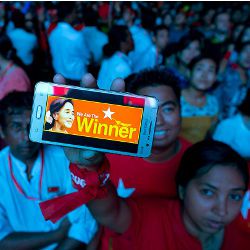
In much of the world personal computing happens with mobile phones. In 2010 the South East Asian country of Myanmar (aka Burma) had the world’s lowest rate of mobile phone penetration. Only 1% of its population had a mobile phone subscription, about the same as its landline penetration.6 The same year war-torn Somalia experienced 7% mobile penetration, and even North Korea had 1.8%. By 2014 Myanmar had jumped to 54% mobile penetration, Somalia had 50%, and the North Koreans just 11%. The government of Myanmar anticipates 80% penetration sometime this year.1
After 20 years of military rule, Myanmar held its first election in 2010. The political party aligned with the government won 80% of contested seats but international observers called the election a sham.9 The opposition National League for Democracy (NLD, the party of Peace Prize laureate Aung San Suu Kyi) didn’t even bother to contest. Contrast November of 2015 when Myanmar held another national election and this time it was viewed as successful.12 The NLD won just under 80% of the contested seats and today is standing up a new government with a close Suu Kyi confident tapped as president.a
It is a stunning set of transformations: In just six years Myanmar increased its mobile phone use by fifty-fold and went from strongman military control to democratic rule. These transformations are both concomitant and connected. After the 2010 sham election the military-controlled government of Myanmar embarked on a series of political transformations. These included real, multi-party elections and a set of market liberalizations that included telecommunication sector reform. The hoped-for outcome of these reforms was inclusive growth brought about by rigorous, well-regulated and nondiscriminatory competition in both the electoral and telecommunication systems.b
In Myanmar’s electoral system, competition came from vigorous participation (and ultimately the landslide victory) of the opposition NLD party. In telecommunications, competition arose when two private sector operators (Ooredoo from Qatar and Telenor of Norway) came in to compete with the preexisting state operator, MPT. The result was explosive growth in services and a precipitous decline in the cost to use a mobile phone. The average price to purchase a SIM card dropped from $150 in 2013 to $1.5 today.2 Today many people in Myanmar can afford mobile phones and are using data plans along with voice apps, such as Viber and Skype. They are also using text-based apps, such as Whatsapp, to stay in touch. One-third of recent survey respondents reported accessing Facebook from their phones.5
Further development of Myanmar’s mobile phone market is expected as sector liberalization proceeds along an internationally established path:
- In 2013, the enactment of a new Telecommunications Law allowing non-state entities including foreign companies to bid for telecommunication service licenses.
- In 2014, the introduction of service by private operators Telenor and Ooredoo using licenses provided for under the new Telecom Law.
- In 2015, steps toward establishing an independent sector regulator. While the Telecom Law made provisions for the establishment of an independent regulator by October 2015, instead by Presidential directive an interim commission was created with the sole task of ensuring that the law to establish the regulator was prepared. In the interim, the Post and Telecommunications Department in the Ministry of Communications and Information Technology continues to be responsible for the regulatory function (T.D. Norbhu, personal communication, February 29, 2016).
- And ultimately reform of the incumbent national operator, the state-owned MPT, which is slowly restructuring into a commercial entity and may eventually be privatized.
Political transformation in Myanmar enabled this market liberalization in the telecommunication sector and the subsequent explosion of mobile phone use. Now the presence of these phones is producing explosive change to politics. During the 2015 election cycle much was made of Myanmar’s “digital election;” citizens traded political information online and election-monitoring apps proliferated.7 But this change was not all positive: new communication technologies served as tools of democratic progress in 2015, but were also used to propagate hate speech, inflame ethnic strife, and diminish democratic growth. Most notoriously, online anti-Muslim messages originated from prominent Buddhist monks, prompting a countermovement by a coalition of civil society activists called the “flower speech” campaign to combat online hate speech and promote communal understanding.13
Scholars have long discussed the Janus-faced role of communication technologies on electoral politics and democratic development.4 As seen in other countries, mobile phones and the Internet can be catalysts of positive democratic change, but they can also be tools for minority subjugation and state control.3 Myanmar offers yet another example of the multiple valances these technologies embody. Social media can be a tool for democratic deepening, hate speech, and political control, all at once.10
Today, Myanmar may be the world’s most exciting telecommunications sector in addition to being one of the world’s most quickly changing political environments. Technologists cannot ignore political and policy environments. They often trump technology. Moreover, policy-makers and politicians cannot ignore Internet and mobile phone technologies. They must ensure the digital revolution supports and does not undermine positive political transformations and inclusive growth. Political and digital transformation go hand-in-hand—you cannot have one without the other.





Join the Discussion (0)
Become a Member or Sign In to Post a Comment